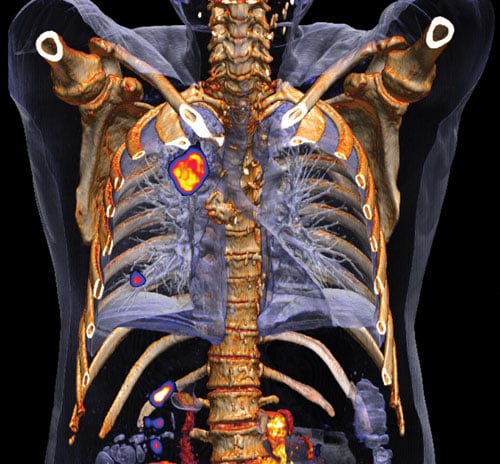
Early detection of cancer lesions with the latest generation of PET/CT scanners supports improved patient management. Yet much of PET’s potential, particularly for following patients and as a component in PET/MR, remains unrealized. (Image courtesy of Siemens Healthcare and the University of Tennessee, Knoxville)
Adopting medical technology because it is new or novel lost its luster a long time ago. It is little wonder then that positron emission tomography/magnetic resonance (PET/MR) has traveled such a bumpy road since the U.S. Food and Drug Administration (FDA) cleared the first PET/MR product in 2011.
Viewed until then primarily as a research tool, the argument for its routine clinical use depended heavily on how this hybrid might spare patients exposure to ionizing radiation compared to its computed tomography (CT)-based cousin. Made at the height of concerns about patient radiation exposure, this argument made sense — but only if clinical claims for increased soft-tissue contrast compared to PET/CT could be validated. Mixed results have since surfaced.
In a medical parody of “he said, she said,” peer-reviewed reports about improved tumor detection with PET/MR have been offset by similar claims favoring PET/CT. Underscoring the challenges faced by this relatively new hybrid is the added cost of PET/MR, as its installation demands architectural changes to accommodate not only the special requirements of the scanner itself but the non-ferrous ancillary equipment that goes with it.
In the face of an underwhelming clinical argument for PET/MR, and in the context of the added costs associated with its installation, the question arises: Why choose
PET/MR over PET/CT? This question is all the more viable when considering the potential of taking PET/CT to the next level.
The latest generation of PET/CT scanners, bolstered by time-of-flight and point-spread function, can visualize more and subtler signs of disease. Moreover, these machines can more precisely measure standard uptake values (SUVs), adding credence to their role in quantifying what has long been a subjective process of interpretation.
There are, unfortunately, challenges. While the increased precision possible with the latest PET/CTs helps in the first-time assessment of patients, it can be problematic in their follow-up, if those patients were previously examined on an older-generation system. Issues arise in the comparison of current exams to priors.
Scanning patients on newer, more powerful PET/CTs can reveal lesions that were previously overlooked, giving the appearance that a therapy is ineffective or the disease has returned. This may happen when the latest images show lesions that were too small to spot on less powerful machines. Additionally, quantitative measurements may be higher because the latest equipment is more sensitive. Different protocols, some of which may be introduced with the availability of new equipment, may further skew interpretations.
SUVs recorded prior to oncologic therapy may serve as baseline measurements for setting PERCIST (PET response criteria in solid tumors) thresholds for individual patients. Research has documented that an increase of 30 percent or more above the PERCIST threshold indicates poor patient response, suggesting that a change in therapy should be considered. Conversely, a decline of 30 percent or more indicates a likely positive effect and that the therapy should be continued.
But an increase in standard uptake values due to the use of a more sensitive PET/CT can throw off the interpretation. There are ways to handle this “apples-and-oranges” dilemma but they are tough to implement.
Guidelines developed by international organizations serving the molecular imaging community have laid out the process for adjusting SUVs to make them comparable. The staff at large academic medical centers may have the wherewithal to do it, but others may not.
Software that can make the necessary conversions has been developed, but at present it has been validated for use only on generations of equipment made by the vendor of that software.
The headwinds holding quantitative PET/CT back are a source of disappointment, to say the least, considering the potential of this hybrid through its SUVs to increase certainty and confidence in the management of patients. The frustration only grows when considering PET/MR.
Although PET is positioned to play a major role in the coming age of value medicine, it can reach its potential only if the quantitative capability inherent in PET/CT or the clinical claims for his cousin PET/MR result in improved patient outcomes. Until this happens, the extraordinary potential of PET will be on hold.
Editor’s note: This column is the culmination of a series of four blogs by industry consultant Greg Freiherr on Where Molecular Imaging Fits in Managing the Cancer. The blogs, “How to Achieve the Quantitative Promise of PET/CT,” “Why the Use of PET/CT in Radiation Therapy Requires Thinking Outside the Box,” “Why Politics Will Define the Next Generation Scanners” and “Will PET/MR Ever be Adopted" can be found at www.itnonline.com/blogs.
Greg Freiherr has reported on developments in radiology since 1983. He runs the consulting service, The Freiherr Group. Read more of his views on his blog at
www.itnonline.com.


 April 24, 2024
April 24, 2024 








